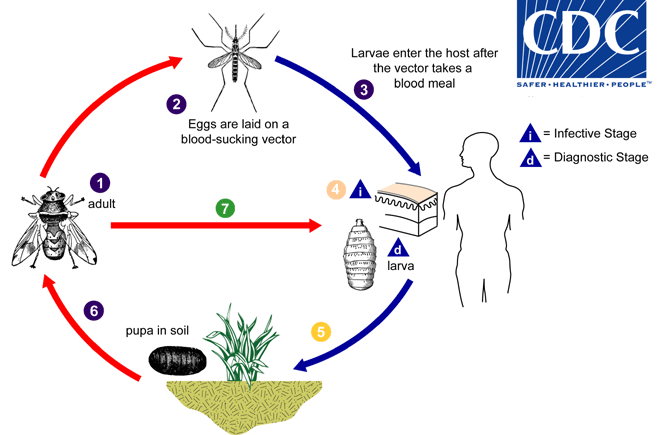S2. Myiasis: What Is It, Causes, Signs and Symptoms, and More
Myiasis, a parasitic condition caused by the infestation of fly larvae—commonly known as maggots—is a medical phenomenon that evokes both curiosity and concern. While relatively rare in developed regions like the United States, it is a condition predominantly found in tropical and subtropical regions such as South America, Africa, and parts of the Caribbean. This article delves into the causes, symptoms, diagnosis, and treatment options for myiasis, providing a comprehensive overview of this fascinating yet distressing medical condition.
What is Myiasis?
Myiasis occurs when fly larvae infest human or animal tissues, feeding on live or necrotic tissue to sustain themselves. The most common culprits are flies from the Diptera order, including species like Dermatobia hominis (commonly known as the human botfly) and Cordylobia anthropophaga (the tumbu fly). Depending on the affected body area, myiasis is classified into various forms:
- Cutaneous Myiasis: Includes furuncular (boil-like lesions), wound myiasis, and migratory myiasis (creeping eruptions).
- Nasopharyngeal Myiasis: Affects the nose, sinuses, and pharynx.
- Ophthalmomyiasis: Involves the eyes.
- Intestinal Myiasis: Occurs when larvae infest the gastrointestinal tract.
- Urogenital Myiasis: Infestation of the urogenital system.
Although it may sound alarming, myiasis is not contagious. Its prevalence is typically tied to specific environmental and hygienic conditions, making travelers to endemic regions more susceptible.

Causes of Myiasis
The root cause of myiasis lies in the reproductive habits of certain flies. Female flies lay their eggs in or near open wounds, moist clothing, or mucous membranes, where the hatched larvae burrow into the host’s tissues. Common scenarios leading to infestation include:
- Direct Egg Deposition: Flies lay eggs directly onto open sores, wounds, or other vulnerable areas.
- Vector Transmission: Some fly species attach their eggs to mosquitoes or ticks. When these intermediary hosts bite humans, the larvae enter through the bite wound.
- Environmental Contamination: Eggs laid on damp clothing, soil, or other surfaces can transfer to the skin and result in infestation.
- Animal Contact: Humans in close contact with infected livestock may inadvertently acquire larvae, especially from species like Hypoderma bovis or Gasterophilus intestinalis.
Though uncommon in developed countries, myiasis poses a risk for individuals with untreated wounds, poor hygiene, or those traveling to high-risk areas.

Recognizing Symptoms of Myiasis
The clinical manifestations of myiasis vary significantly based on its type and location within the body. Below is a summary of symptoms associated with each form:
- Cutaneous Myiasis:
- Furuncular Myiasis: Painful, boil-like lesions that may produce pus or discharge. Patients often report a sensation of movement within the lesion.
- Wound Myiasis: Visible larvae within open wounds, accompanied by systemic symptoms such as fever and chills.
- Migratory Myiasis: Larvae burrow beneath the skin, creating red, thread-like trails indicative of their movement.
- Nasopharyngeal Myiasis:
- Symptoms include nasal obstruction, foul-smelling discharge, nosebleeds, and occasionally visible larvae.
- Ophthalmomyiasis:
- Patients experience eye irritation, redness, excessive tearing, and swelling around the eyelids. Severe cases may lead to vision impairment.
- Intestinal Myiasis:
- Symptoms include abdominal pain, vomiting, and diarrhea due to larvae present in the gastrointestinal tract.
- Urogenital Myiasis:
- Presents with symptoms such as painful urination (dysuria) and blood in the urine (hematuria).
Prompt diagnosis and treatment are essential to prevent complications such as secondary infections or extensive tissue damage.

Diagnosing Myiasis
Diagnosing myiasis begins with a detailed medical history and physical examination, especially in individuals with recent travel to endemic regions. Diagnostic methods include:
- Clinical Observation: Direct visualization of larvae within wounds or lesions is often sufficient for diagnosis.
- Laboratory Tests: Blood tests may reveal leukocytosis or eosinophilia, indicative of an immune response to parasitic infection.
- Imaging Studies: Ultrasound, MRI, or CT scans can be used to locate deeply embedded larvae or assess the extent of tissue involvement.
- Biopsy: Rarely performed, biopsies may confirm the presence of larvae and associated inflammation.
A thorough assessment not only identifies the infestation but also rules out other conditions with similar presentations.

Treatment Options for Myiasis
The approach to treating myiasis depends on its severity and location. Common treatment modalities include:
- Larvae Extraction:
- For cutaneous myiasis, topical applications such as petroleum jelly or liquid paraffin are used to suffocate the larvae. This forces them to emerge, allowing for manual removal with tweezers.
- In more severe cases, surgical removal may be necessary, particularly when larvae are deeply embedded.
- Antiparasitic Medications:
- Ivermectin, an antiparasitic drug, is effective in killing larvae and is often used in conjunction with other treatments.
- Wound Care:
- Proper hygiene of infested wounds is critical. Antiseptic dressings and antibiotics may be administered to prevent secondary infections.
- Supportive Care:
- Pain relief, anti-inflammatory medications, and supportive therapies may be provided to alleviate symptoms and aid recovery.
Early intervention is key to minimizing complications, which can include secondary infections, scarring, and, in severe cases, systemic illness.

Prevention of Myiasis
Preventive measures play a significant role in mitigating the risk of myiasis, particularly for travelers to endemic regions. Recommendations include:
- Maintaining Hygiene: Proper wound care and keeping skin clean can significantly reduce the risk of larvae infestation.
- Protective Clothing: Wearing long sleeves and pants, particularly in areas with high fly populations, provides a physical barrier against egg deposition.
- Insect Repellents: Applying repellents to skin and clothing deters flies and other insects.
- Avoiding Contaminated Surfaces: Refrain from leaving damp clothing outdoors, as it may attract flies.
Key Takeaways About Myiasis
- Myiasis is a parasitic infestation caused by fly larvae, primarily affecting the skin but capable of targeting other tissues.
- The condition is most prevalent in tropical and subtropical regions but can occur anywhere given the right circumstances.
- Diagnosis involves a combination of clinical observation, medical history, and, in some cases, imaging studies.
- Treatment ranges from manual extraction of larvae to surgical intervention, often complemented by antiparasitic medications.
- Preventive measures such as good hygiene, protective clothing, and insect repellents are essential, especially for travelers.
Related articles
The Latest
P4. Viral “Half Pig, Half Human Baby” Story Debunked: Why We Must Verify What We Share Online
Stories that go viral on social media often captivate our attention with shocking or unbelievable headlines. One such example that surfaced earlier this year claimed that a half pig, half human baby had been born and survived in Kenya. The ...
P2. Viral “Half Pig, Half Human Baby” Story Debunked: Why We Must Verify What We Share Online
Stories that go viral on social media often captivate our attention with shocking or unbelievable headlines. One such example that surfaced earlier this year claimed that a half pig, half human baby had been born and survived in Kenya. The ...
P1. Viral “Half Pig, Half Human Baby” Story Debunked: Why We Must Verify What We Share Online
Stories that go viral on social media often captivate our attention with shocking or unbelievable headlines. One such example that surfaced earlier this year claimed that a half pig, half human baby had been born and survived in Kenya. The ...
P4. She was in his cell, waiting to be executed, and he asked as a last…See more
For many incarcerated individuals in South Carolina, life on death row is defined not only by the severity of their sentence but also by the harsh realities of confinement. In recent years, attention has turned to the extended periods of ...
P2. She was in his cell, waiting to be executed, and he asked as a last…See more
For many incarcerated individuals in South Carolina, life on death row is defined not only by the severity of their sentence but also by the harsh realities of confinement. In recent years, attention has turned to the extended periods of ...
 P3. A CHEATING Men NEVER Leave His Wife Because...
P3. A CHEATING Men NEVER Leave His Wife Because... P2. 18 Benefits: Mix Ginger with Cloves and Honey, You’ll Thank Me for the Recipe!
P2. 18 Benefits: Mix Ginger with Cloves and Honey, You’ll Thank Me for the Recipe!-1750606359-q80.webp) P3. A Single Dad’s Unexpected Morning Surprise Turns Into a Life-Changing Friendship
P3. A Single Dad’s Unexpected Morning Surprise Turns Into a Life-Changing Friendship P3. I came home and found my humiliated wife crying behind a closed door
P3. I came home and found my humiliated wife crying behind a closed door







-1751633505-q80.webp)

